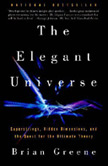| Free Jyotish Newsletter |
 Jyotish.ws
Jyotish.wsBook and DVD Review: "The Elegant Universe" by Brian Greene
Review by Deborah Allison
 Until a few centuries ago, astrology and astronomy were one and the same. Even Sir Isaac Newton, who discovered the laws of motion that describe the movement of the planets very accurately, regarded astrology as his primary motivation for exploring gravity and motion. Now, although astrology and cosmology have gone their separate ways, the grand story of the nature of time and space continues to evolve.
Until a few centuries ago, astrology and astronomy were one and the same. Even Sir Isaac Newton, who discovered the laws of motion that describe the movement of the planets very accurately, regarded astrology as his primary motivation for exploring gravity and motion. Now, although astrology and cosmology have gone their separate ways, the grand story of the nature of time and space continues to evolve.
In our time, we often embed these new perceptions and instincts about the nature of the cosmos in the equations of physics. This mathematical language of reality describes our knowledge in abstract ways that are no less wondrous than the old myths that have always carried our beliefs and perceptions. And the advances in physics in recent decades are indeed quite incredible.
The story of the growth of our knowledge of physical reality over the last century is told with clarity, energy and humor by physicist Brian Greene in his Pulitzer Prize finalist book "The Elegant Universe" and his more recent work, "The Fabric of the Cosmos." Both are "compulsively readable," as one reviewer put it. The books have the same flavor of human drama and intellectual adventure that one finds in "The Da Vinci Code" (with a considerably less frenetic pace). Greene is an eminent physicist deeply involved in his subject matter. He is also a gifted story teller. His excitement and sense of wonder about the astounding and totally unanticipated discoveries of the last 100 years are contagious and keep the books moving along.
As if that were not enough, Greene is also a terrific TV personality, the narrator and central figure of a three-hour NOVA presentation of "The Elegant Universe" on PBS a few years ago. The video or DVD from this series contains wonderfully clear and often amusing visual images and animations of modern physical ideas about the cosmos, as well as common-sense interviews with many of the physicists who originally discovered all this. As you might expect, the video is even more approachable than the books. As in the two books, Greene manages to tell a very clear and comprehensible story without using any mathematics at all. For those who miss the math, he has provided some of it in the extensive footnotes at the end of both books.
Many of the new developments in physics have come about as a result of looking at extremes of space and time well beyond the human range of experience. Greene starts with Newton, whose perspective was distinctly human, and shows how Einstein thought through the ways you would have to revise Newton's theories if you imagine that you are traveling at nearly the speed of light. The revolutionary result was special relativity, in which space and time are unified as four- dimensional space-time. The next step, also Einstein's, was to extend relativity to extremely large distances and masses--the universe, in fact--where the dominant role is played by gravity. The result was a second revolution, general relativity, involving a rethinking of what gravity really is.
At about the same time, other physicists were examining the other end of the spectrum--extremely small distances, masses and times--and found a world completely at odds with Einstein's and our own experience. Instead of smoothness and certainty, they found chaotic turbulence and uncertainty in the mysterious world of quantum mechanics. This dramatic and unresolved contrast (or even conflict) in models of the very big and the very small played out over the next half-century as physicists continued exploring the extremely large and massive (the starlight that travels billions of years before reaching us, and the expansion of the universe) and the extremely small and dense (the center of the very early universe, where perhaps time starts, and the center of a black hole, where perhaps time stops, both a billionth of a billionth of a centimeter).
Today these two incompatible perspectives, relativity and quantum mechanics, may be approaching reconciliation and unification in the context of superstring theory and its offspring, M-theory, with astounding consequences such as multiple life-filled dimensions in our universe (as many as 14 dimensions at last count) and multiple universes (infinite at last count). And this is physics, not metaphysics!
Greene tells this whole grand story. Read or view it and enjoy.
The Elegant Universe by Brian Greene. The book is available at bookstores and can be ordered online. The video or DVD may be available at your local library or bookstore. You can buy the video or DVD, or view it online for free at: www.pbs.org
(c) copyright 2007 Michael Laughrin
From the April/May 2007 issue of Michael Laughrin's North American Jyotish Newsletter. Click to subscribe to this free Jyotish newsletter.
Read more articles.
Yagyas offered by Michael Laughrin.